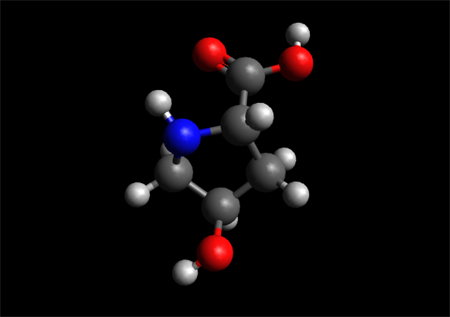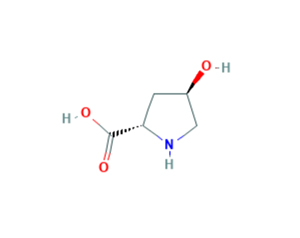Hydroxyproline Molecule-- Space Filled Model

- Molecular formula : C5H9NO3
- Molecular weight : 131.131 g·mol−1
Hydroxyproline differs from proline by the presence of a hydroxyl (OH) group attached to the gamma carbon atom. See image below.

Molecular Structure of Hydroxyproline
General
Hydroxyproline is a major component of the protein collagen, comprising roughly 13.5% of mammalian collagen. Hydroxyproline and proline play key roles for collagen stability. They permit the sharp twisting of the collagen helix. In the canonical collagen Xaa-Yaa-Gly triad (where Xaa and Yaa are any amino acid), a proline occupying the Yaa position is hydroxylated to give a Xaa-Hyp-Gly sequence. This modification of the proline residue increases the stability of the collagen triple helix. It was initially proposed that the stabilization was due to water molecules forming a hydrogen bonding network linking the prolyl hydroxyl groups and the main-chain carbonyl groups. It was subsequently shown that the increase in stability is primarily through stereoelectronic effects and that hydration of the hydroxyproline residues provides little or no additional stability.
Hydroxyproline is produced by hydroxylation of the amino acid proline by the enzyme prolyl hydroxylase following protein synthesis (as a post-translational modification). The enzyme catalyzed reaction takes place in the lumen of the endoplasmic reticulum. Although it is not directly incorporated into proteins, hydroxyproline comprises roughly 4% of all amino acids found in animal tissue, an amount greater than seven other amino acids that are translationally incorporated.
Clinical Significance
Proline hydroxylation requires ascorbic acid (vitamin C). The most obvious, first effects (gingival and hair problems) of absence of ascorbic acid in humans come from the resulting defect in hydroxylation of proline residues of collagen, with reduced stability of the collagen molecule, causing scurvy. Increased serum and urine levels of hydroxyproline have also been demonstrated in Paget's disease.
Molecules of Life Resources
Explain it with Molecules
- Why is water such a good solvent?
- Why does ice float?
- Why do solids, liquids and gases behave differently?
- What is the geometry of methane?
- What's the difference between alpha and beta glucose?
- How does caffeine work in the brain?
- How does soap work?
- What is the difference between sucrose and fructose?
- Why is carbon monoxide so dangerous?
- Why is graphite so soft if it is made of only carbon?
- What is the difference between Carbyne and Graphite?
- Why is the fullerene and similar structures the cornerstone of nanotechnology?
- How big is a nanotube?
- Why does table salt have a cubic crystal shape?
- What is the structure of the benzene molecule?
- Why do carcinogens cause cancer?
- What causes Sickle Cell Anemia?
- What is the difference between sodium nitrite and nitrate?
- How do drugs work?